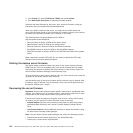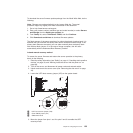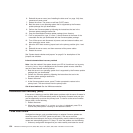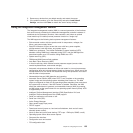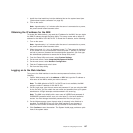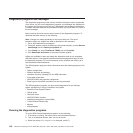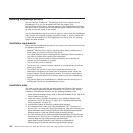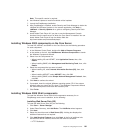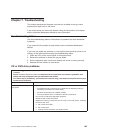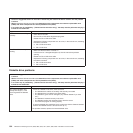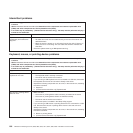
Note: The DSA Preboot diagnostics program might appear to be unresponsive
for an unusual length of time when you start the program. This is normal
operation while the program loads.
4. Optionally, select Quit to DSA to exit from the stand-alone memory diagnostics
program.
Note: After you exit from the stand-alone memory diagnostics environment, you
must restart the server to access the stand-alone memory diagnostics
environment again.
5. Select gui to display the graphical user interface, or select cmd to display the
DSA interactive menu.
6. Follow the instructions on the screen to select the diagnostic test to run.
If the diagnostics programs do not detect any hardware errors but the problem
remains during normal server operations, a software error might be the cause. If
you suspect a software problem, see the information that comes with your software.
A single problem might cause more than one error message. When this happens,
correct the cause of the first error message. The other error messages usually will
not occur the next time you run the diagnostics programs.
Exception: If multiple error codes or LEDs indicate a microprocessor error, the
error might be in a microprocessor or in a microprocessor socket. See
“Microprocessor problems” on page 168 for information about diagnosing
microprocessor problems.
If the server stops during testing and you cannot continue, restart the server and try
to run the diagnostics programs again. If the problem remains, replace the
component that was being tested when the server stopped.
For a list of diagnostics messages, see the Hardware Maintenance Manual.
Advanced Settings Utility program
The Advanced Settings Utility (ASU) program is an alternative to the Setup Utility
for modifying UEFI settings. Use the ASU program online or out of band to modify
UEFI settings from the command line without the need to restart the system to
access the Setup Utility.
You can also use the ASU program to configure the optional remote presence
features or other IMM settings. The remote presence features provide enhanced
systems-management capabilities.
In addition, the ASU program provides limited settings for configuring the IPMI
function in the IMM through the command-line interface.
Use the command-line interface to issue setup commands. You can save any of the
settings as a file and run the file as a script. The ASU program supports scripting
environments through a batch-processing mode.
Chapter 6. Configuring the server 159




